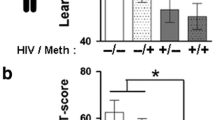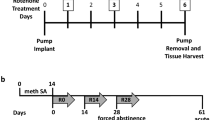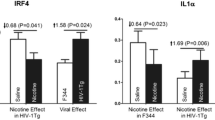Abstract
We recently reported that six consecutive days of treatment with a moderate dose of methamphetamine (METH) induced greater behavioral sensitization in adult HIV-1 transgenic (HIV-1 Tg) rats than in adult Fischer 344/NHsd (F344) non-transgenic, wild-type control animals. In the present study, we evaluated the effects of a moderate dose of METH on the brains of adolescent versus adult HIV-1 Tg male rats using both behavioral (METH-induced, stereotypic head movement) and physiological (rectal body temperature) parameters. We found that both the acute and behavior-sensitizing effects of METH were greater in HIV-1 Tg rats compared with controls and also in adolescent rats compared with adult animals, regardless of HIV-1 status. We determined that acute hyperthermic effects of METH as well as tolerance to METH-induced hyperthermia were greater in HIV-1 Tg rats than in controls. Taken together, these results suggest that both the neuroadaptations seen in HIV infection and the immaturity of the adolescent brain are associated with increased sensitivity to the psychoactive and behavior-sensitizing properties of METH. Thus, HIV-infected individuals and adolescents may be more vulnerable to the development of METH abuse and dependence than non-infected individuals and adults.





Similar content being viewed by others
References
Abekawa T, Ohmori T, Koyama T (1997) Tolerance to the neurotoxic effect of methamphetamine in rats behaviorally sensitized to methamphetamine or amphetamine. Brain Res 767:34–44
Anderson SL, Teicher MH (2009) Desperately driven and no breaks: developmental stress exposure and subsequent risk for substance abuse. Neurosci Biobehav Rev 33:516–524
Antinori A, Arendt G, Becker JT, Brew BJ, Byrd DA, Cherner M, Clifford DB, Cinque P, Epstein LG, Goodkin K, Gisslen M, Grant I, Heaton RK, Joseph J, Marder K, Marra CM, McArthur JC, Nunn M, Price RW, Pulliam L, Robertson KR, Sacktor N, Valcour V, Wojna WE (2007) Updated research nosology for HIV-associated neurocognitive disorders. Neurology 69:1789–1799
Assis MA, Hansen C, Lux-Lantos V, Cancela LM (2009) Sensitization to amphetamine occurs simultaneously at immune level and in met-enkephalin of the nucleus accumbens and spleen: An involved NMDA glutamatergic mechanism. Brain Behav Immune 23:464–473
Baucum AJ, Rau KS, Riddle EL, Hanson GR, Fleckenstein AE (2004) Methamphetamine increases dopamine transporter higher molecular weight complex formation via a dopamine- and hyperthermia-associated mechanism. J Neurosci 24:3436–3443
Belcher AM, O’Dell SJ, Marshall JF (2006) A sensitizing regimen of methamphetamine causes impairments in a novelty preference task of object recognition. Behav Brain Res 170:167–172
Berridge KC, Kringelbach ML (2008) Affective neuroscience of pleasure: reward in humans and animals. Psychopharmacology 199:457–480
Brown PL, Bae D, Kiyatkin EA (2007) Relationships between locomotor activation and alterations in brain temperature during selective blockade and simulation of dopamine transmission. Neuroscience 145:335–343
Callaway CW, Clark RF (1994) Hyperthermia in psychostimulant overdose. Ann Emerg Med 24:68–76
Carrico AW, Johnson MO, Morin SF, Remien RH, Riley ED, Hecht FM, Fuchs D (2008) Stimulant use is associated with immune activation and depleted tryptophan among HIV-positive persons on anti-retroviral therapy. Brain Behav Immune 22:1257–1262
Chang L, Ernst T, Speck O, Grob CS (2005) Additive effects of HIV and chronic methamphetamine use on brain metabolite abnormalities. Am J Psychiatry 162:361–369
Crombag HS, Badiani A, Chan J, Dell’Orco J, Dineen SP, Robinson TE (2001) The ability of environmental context to facilitate psychomotor sensitization to amphetamine can be dissociated from its effect on acute drug responsiveness and on conditioned responding. Neuropsychopharmacology 24:680–690
Dallmann R, Steinlechner S, von Hörsten S, Karl T (2006) Stress-induced hyperthermia in the rat: comparison of classical and novel recording methods. Lab Anim 40:186–193
Fasano A, Barra A, Nicosia P, Rinaldi F, Bria P, Bentivoglio AR, Tonioni F (2008) Cocaine addiction: from habits to stereotypical-repetitive behaviors and punding. Drug Alcohol Depend 29:178–182
Feil J, Sheppard D, Fitzgerald PB, Yucel M, Lubman DI, Bradshaw JL (2010) Addiction, compulsive drug seeking, and the role of frontostriatal mechanisms in regulating inhibitory control. Neurosci Biobehav Rev. doi:10.1016/j.neubiorev.2010.03.001
Ferris MJ, Mactutus CF, Booze RM (2008) Neurotoxic profiles of HIV, psychostimulant drugs of abuse, and their concerted effects on the brain: current status of dopamine system vulnerability in neuroAIDS. Neurosci Biobehav Rev 32:883–909
Huevel OA, Werf YD, Verhoef KMW, de Witt S, Berendse HW, Wolters EC, Veltman DJ, Gorenewegen HJ (2009) Frontal–striatal abnormalities underlying behaviors in the compulsive–impulsive spectrum. J Neurol Sci 289(1):55–59
Itzhak Y, Martin JL, Black MD, Ali SF (1998) Effect of melatonin on methamphetamine- and 1-methyl-4-phenyl-1, 2, 3, 6-tetrahydropyridine-induced dopaminergic neurotoxicity and methamphetamine-induced behavioral sensitization. Neuropharmacol 37:781–791
Itzhak Y, Marin JL, Ali SF (2002) Methamphetamine-induced dopaminergic neurotoxicity in mice: long-lasting sensitization to the locomotor stimulation and desensitization to the rewarding effects of methamphetamine. Prog Neuropsychopharmacol Biol Psychiatry 26:1177–1183
Jernigan TL, Gamst AC, Archibald SL, Fennema-Notestine C, Rivera-Mindt M, Marcatte TL, Heaton RK, Ellis RS, Grant I (2005) Effects of methamphetamine dependence and HIV infection on cerebral morphology. Am J Psychiatry 162:1461–1472
Kalechstein AD, Jentsch JD, Kantak KM (2008) Stimulant-associated cognitive abnormalities: mechanisms and impact on reward-related behavior and addiction. Drug Alcohol Depend 97:276–280
Kopinsky KL, Bao J, Lin YW (2007) Neurobiology of HIV, psychiatric and substance abuse comorbidity research: workshop report. Brain Behav Immun 21:428–441
LaShomb AL, Vigorito M, Chang SL (2009) Further characterization of the spatial learning deficit in the human immunodeficiency virus-1 transgenic rat. J Neurovirol 15:14–24
Li C-sR, Sinha R (2008) Inhibitory control and emotional stress regulation: neuroimaging evidence for frontal-limbic dysfunction in psycho-stimulant addiction. Neurosci Biobehav Rev 32:581–597
Liu X, Chang L, Vigorito M, Kass M, Li H, Chang SL (2009) Methamphetamine-induced behavioral sensitization is enhanced in the HIV-1 transgenic rat. J Neuroimmune Pharmacol 4:309–316
Paus T, Keshavan M, Giedd JN (2008) Why do many psychiatric disorders emerge during adolescence? Nat Rev Neurosci 9:947–957
Peng J, Vigorito M, Liu X, Zhou D, Wu X, Chang SL (2010) The HIV-1 transgenic rat as a model for HIV-1 infected individuals given HAART. J Neuroimmunol 218:94–101
Pruznak AM, Hong-Brown L, Lantry R, She P, Frost RA, Vary TC, Lang CH (2008) Skeletal and cardiac myopathy in HIV-1 transgenic rats. Am J Physiol Endocrinol Metab 295:E964–E973
Reid W, Sadowska M, Denaro F, Rao S, Foulke J Jr, Hayes N, Jones O, Doodnauth D, Davis H, Sill A, O’Driscoll P, Huso D, Fouts T, Lewis G, Hill M, Kamin-Lewis R, Wei C, Ray P, Gallo RC, Reitz M, Bryant J (2001) An HIV-1 transgenic rat that develops HIV-related pathology and immunologic dysfunction. Proc Natl Acad Sci U S A 98:9271–9276
Riddle EL, Kokoshka JM, Wilkins DG, Hanson GR, Fleckenstein AE (2002) Tolerance to the neurotoxic effects of methamphetamine in young rats. Eur J Pharmacol 435:181–185
Robinson TE, Berridge KC (1993) The neural basis of drug craving: an incentive sensitization theory of addiction. Brain Res Rev 8:247–291
Robinson TE, Berridge KC (2001) Mechanisms of action of addictive stimuli: incentive-sensitization and addiction. Addiction 96:103–114
Robinson TE, Berridge KC (2004) Incentive-sensitization and drug ‘wanting’. Psychopharmacol 171:352–353
Robinson TE, Berridge KC (2008) The incentive-sensitization theory of addiction: some current issues. Philos Trans R Soc Lond B Biol Sci 363:3137–3146
Sanchez-Alavez M, Gombart LM, Huitron-Resendiz S, Carr JR, Wills DN, Berg G, Campbell IL, Gauvin DV, Henriksen SJ, Criado JR (2004) Physiological and behavioral effects of methamphetamine in a mouse model of endotoxemia: a preliminary study. Pharmacol Biochem Behav 77:365–370
Sekine Y, Minabe Y, Kawai M, Suzuki K, Iyo M, Isoda H, Sakahara H, Ashby CR, Takei N, Mori N (2002) Metabolite alterations in basal ganglia associated with methamphetamine-related psychiatric symptoms: a proton MRS study. Neuropsychopharmacology 27:453–461
Substance Abuse and Mental Health Services Administration (2009) Results from the 2008 national survey on drug use and health: National findings. Office of Applied Studies, NSDUH Series H-36, HHS Publication No. SMA 09-4434. Rockville, MD.
Vigorito M, LaShomb AL, Chang SL (2007) Spatial learning and memory in HIV-1 transgenic rats. J Neuroimmune Pharmacol 2:319–328
Wang G-J, Chang L, Volkow ND, Telang F, Logan J, Ernst T, Fowler JS (2004) Decreased brain dopaminergic transporters in HIV-associated dementia patients. Brain 127:2452–2458
Zakharova E, Leoni G, Kichko I, Izenwasser S (2009) Differential effects of methamphetamine and cocaine on conditioned place preference and locomotor activity in adult and adolescent male rats. Behav Brain Res 198:45–50
Author information
Authors and Affiliations
Corresponding author
Additional information
Guarantors of the work: Sulie L. Chang
Source of support: Supported, in part, by NIH K24 grant DA16170 to LC and NIH K02 grant DA016149 to SLC.
Rights and permissions
About this article
Cite this article
Kass, M.D., Liu, X., Vigorito, M. et al. Methamphetamine-Induced Behavioral and Physiological Effects in Adolescent and Adult HIV-1 Transgenic Rats. J Neuroimmune Pharmacol 5, 566–573 (2010). https://doi.org/10.1007/s11481-010-9221-z
Received:
Accepted:
Published:
Issue Date:
DOI: https://doi.org/10.1007/s11481-010-9221-z




